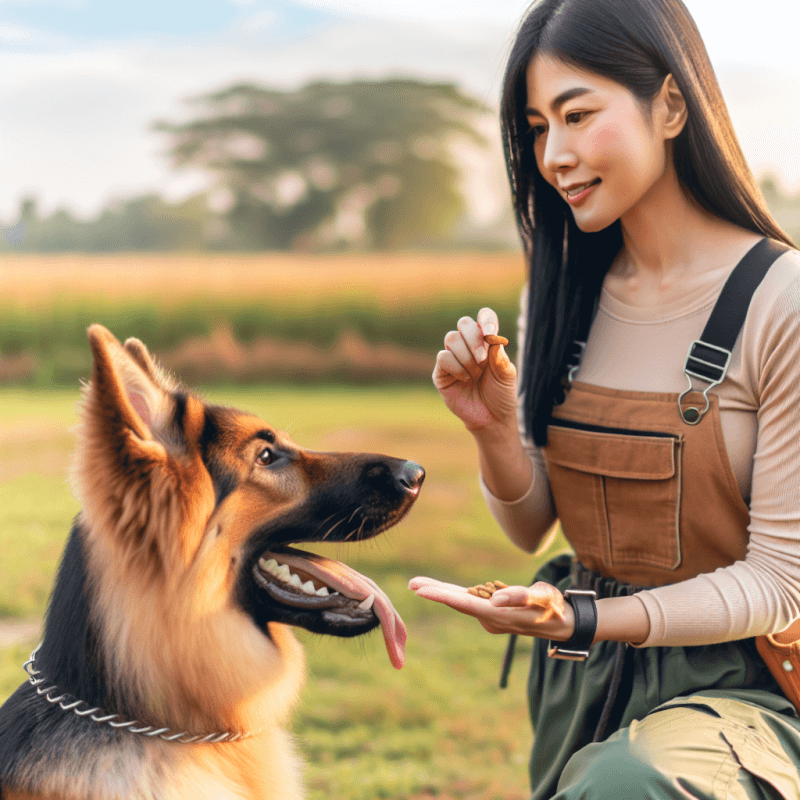Are you struggling to understand your furry friend’s behavior or wondering how to effectively train your dog? Look no further than “Dog Training And Animal Behavior.” This comprehensive article explores the fascinating world of dog training and animal behavior, offering valuable insights and expert advice to help you build a strong bond with your four-legged companion. Gain a deeper understanding of why dogs behave the way they do, learn effective training techniques, and discover how to address common behavioral issues. Whether you’re a new dog owner or have been sharing your life with canines for years, this article is a must-read for anyone seeking a harmonious relationship with their furry friend.

The Importance of Dog Training
Building a Strong Bond with Your Dog
Dog training is not just about teaching your furry friend a few tricks or commands; it is also an essential tool for building a strong bond with your dog. When you invest time and effort into training your dog, it establishes a sense of trust and respect between the two of you. Through training sessions, both you and your dog learn to communicate effectively and understand each other’s needs and expectations.
Ready for Cat Trivia?
Test your knowledge about cats!

Training sessions can be a fun and rewarding experience for both you and your dog. It allows you to spend quality time together, strengthening the emotional connection between you and your furry companion. By engaging in training activities regularly, you will create a lasting bond based on mutual understanding and trust.
Ensuring Safety and Well-being
Another crucial aspect of dog training is ensuring the safety and well-being of your four-legged friend. A well-trained dog is less likely to engage in risky or dangerous behaviors, reducing the chances of accidents or injuries. Training helps you teach your dog the boundaries and rules that keep them safe in various situations, such as crossing the road or interacting with strangers.
Furthermore, training plays a significant role in preventing behavioral problems that can hinder your dog’s overall well-being. By addressing behavioral issues early on through training, you can ensure that your dog leads a happy, healthy, and well-adjusted life.
Improving Communication and Understanding
Have you ever wished you could understand what your dog is trying to tell you? Well, through dog training, you can enhance your communication and understanding of your furry companion. Dogs communicate primarily through body language and vocalizations, and by learning to interpret these signals, you can better meet your dog’s needs and provide a nurturing environment.
Training helps you and your dog establish a common language. You can teach your dog basic commands and cues that will enable you to communicate effectively, such as sit, stay, or come. As your dog becomes more proficient in understanding and responding to your commands, you will be amazed at the level of communication you can achieve.
Understanding Animal Behavior
The Role of Instincts
To effectively train your dog, it is essential to have a basic understanding of animal behavior, particularly the role of instincts. Instincts are innate behaviors that dogs are born with. These instincts are deeply rooted in their evolutionary history and serve as a survival mechanism.
For instance, a dog’s instinct to mark territory or protect their pack demonstrates the need to establish boundaries and ensure safety. Understanding these instincts can help you tailor your training techniques to align with your dog’s natural behavior patterns.
Socialization and Pack Mentality
Dogs are social animals with a pack mentality. In the wild, dogs rely on their pack for survival and structure. Understanding this aspect of their behavior is crucial for successful training.
Socialization plays a significant role in a dog’s overall development and behavior. Introducing your dog to different people, animals, and environments during their early stages of life helps them develop positive associations and adaptability. By exposing your dog to various social situations, you can help them become well-rounded and confident companions.
Furthermore, recognizing and implementing pack mentality concepts into training can help establish your role as the pack leader. Dogs need clear leadership and guidance to feel secure and have a sense of structure. By assuming the role of a confident and consistent leader, you can enhance the effectiveness of your training sessions.
Learning and Conditioning
Just like humans, dogs are capable of learning and can be conditioned to respond to specific stimuli. Understanding the principles of learning and conditioning can significantly impact the success of your training efforts.
Positive reinforcement is one of the most effective training techniques. By rewarding desired behaviors with treats, praise, or playtime, you encourage your dog to repeat these behaviors in the future. Dogs thrive on positive feedback and are more motivated to learn when they are rewarded for their efforts.
Consistency and patience are also crucial when training your dog. Dogs learn best through repetition, so it is important to establish a consistent training routine and reinforce the desired behaviors consistently. Patience is essential as dogs learn at their own pace, and it may take time for them to grasp new commands or behaviors.
Basic Principles of Dog Training
Positive Reinforcement
Positive reinforcement is a fundamental principle of dog training that focuses on rewarding desired behaviors. By using treats, praise, or playtime as rewards, you can motivate your dog to learn and exhibit appropriate behaviors. Positive reinforcement creates a positive association with training and strengthens the bond between you and your furry friend.
When using positive reinforcement, it is important to reward your dog immediately after they perform the desired behavior. This helps them understand which behavior is being reinforced and encourages them to repeat it in the future. Consistency is key when using positive reinforcement, as it helps your dog understand what is expected of them.
Consistency and Patience
Consistency and patience are vital when training your dog. Dogs learn through repetition and need consistent cues and commands to understand what is expected of them. Using the same commands and cues consistently helps your dog associate them with specific behaviors.
It is important to be patient with your dog during the training process. Dogs learn at their own pace, and not all dogs will grasp new commands or behaviors immediately. Stay calm and patient, and remember that positive reinforcement and repetition will yield results over time. Celebrate small victories and be consistent in your training efforts.
Clear Communication and Commands
Clear communication is the key to successful training. Dogs rely on clear and consistent cues to understand what is expected of them. Use simple, one-word commands that are easy to understand, such as sit, stay, or come.
Pair each command with a specific gesture or hand signal to reinforce your verbal cues. Dogs are highly observant of body language, so using consistent gestures will help them understand your commands even when verbal communication may not be possible.
Speak in a firm yet friendly tone when giving commands. Avoid using harsh or aggressive tones, as this can confuse or scare your dog. Remember to give your dog time to process your commands and respond before repeating them.
Common Behavioral Issues
Aggression and Reactivity
Aggression and reactivity are common behavioral issues in dogs that can be addressed through training. Aggressive behaviors, such as growling, biting, or lunging, may stem from fear, anxiety, or a desire to assert dominance.
Training can help manage and modify aggressive behaviors by addressing the underlying causes. Techniques such as desensitization and counter-conditioning can be used to help your dog develop positive associations with triggers that provoke aggression.
If your dog exhibits aggression or reactivity, it is important to seek professional help from a certified dog trainer or behaviorist. They can assess the situation and create a tailored training plan to address these issues safely and effectively.
Separation Anxiety
Separation anxiety is a common issue in dogs that can result in destructive behaviors when left alone. Dogs with separation anxiety may exhibit excessive barking, whining, pacing, or destructive chewing.
Training can help alleviate separation anxiety by gradually acclimating your dog to being alone. Start by leaving your dog alone for short periods and gradually increase the duration over time. Provide your dog with engaging toys or activities to keep them occupied while you are away.
Creating a calm and routine environment can also help reduce separation anxiety. Avoid making a fuss when leaving or returning home, as this can heighten their anxiety. Instead, establish a predictable routine that your dog can rely on, which helps them feel secure and less anxious.
Excessive Barking
Excessive barking is a common behavioral issue that can be addressed through training. Dogs may bark excessively due to boredom, fear, alertness, or seeking attention.
To address excessive barking, it is important to understand the underlying cause. If your dog is barking out of boredom, providing mental and physical stimulation through interactive toys or regular exercise can help redirect their energy in a positive way.
For dogs that bark out of fear or anxiety, desensitization and counter-conditioning techniques can help modify their behavior. Identifying the triggers that provoke excessive barking and gradually exposing your dog to these triggers under controlled circumstances can help them develop a more positive response.

Creating a Training Routine
Setting Goals and Objectives
When embarking on a training journey with your dog, it is important to set clear goals and objectives. Determine what behaviors or commands you want to teach your dog and outline a plan to achieve these goals.
Setting realistic and achievable goals ensures that you stay motivated and focused throughout the training process. Start with basic commands and behaviors, and gradually progress to more advanced training as your dog becomes proficient.
Establishing Rules and Boundaries
Establishing clear rules and boundaries is an essential part of the training process. Dogs thrive in an environment with structure and consistency, as it helps them understand what is expected of them.
Determine the boundaries and rules that are important for your household, such as not jumping on furniture or waiting patiently at doorways. Reinforce these boundaries consistently through training and positive reinforcement.
Consistency is key when establishing rules and boundaries. Ensure that all family members are on the same page and enforce these rules consistently. This will prevent confusion and make it easier for your dog to understand and adhere to the established boundaries.
Reward Systems
Reward systems play a crucial role in motivating your dog during training. Positive reinforcement, such as treats, praise, or playtime, can be used as rewards to encourage desired behaviors.
Establish a reward system that works for you and your dog. Determine what rewards are most motivating for your furry friend and use them consistently during training sessions. Gradually reduce the frequency of rewards as your dog becomes more proficient in performing the desired behaviors.
Remember to always reward your dog immediately after they exhibit the desired behavior to reinforce the connection between the behavior and the positive outcome. Celebrate small victories and make training a positive and enjoyable experience for both you and your dog.
Training Techniques and Methods
Clicker Training
Clicker training is a popular and effective training technique that uses a small handheld device called a clicker. The clicker produces a distinct sound when pressed, which serves as an instant marker to indicate the desired behavior.
Clicker training involves pairing the sound of the clicker with a reward, such as a treat. This helps create a positive association between the sound and the reward. The clicker serves as a precise and consistent way to communicate with your dog during training.
To use clicker training, start by associating the sound of the clicker with a treat. Click the clicker and immediately give your dog a treat. Repeat this process multiple times until your dog understands that the clicker sound is always followed by a reward. Once your dog understands this association, you can use the clicker to mark desired behaviors as they occur.
Marker Training
Marker training is similar to clicker training, but instead of using a clicker, you use a verbal marker, such as the word “yes” or “good.” Marker training involves associating the verbal marker with a reward, just like in clicker training.
To use marker training, start by saying the verbal marker and immediately providing a reward, such as a treat. Repeat this process multiple times until your dog understands the association between the verbal marker and the reward. Once your dog understands this association, you can use the verbal marker to mark desired behaviors during training.
Marker training can be especially useful in situations where using a clicker may not be practical or feasible. It allows for clear communication and reinforcement of desired behaviors.
Reward-Based Training
Reward-based training, also known as positive reinforcement training, is a gentle and effective training method that focuses on rewarding desired behaviors. This training technique relies on positive reinforcement, such as treats, praise, or playtime, to motivate your dog to repeat the desired behaviors.
To use reward-based training, start by identifying the behaviors you want to reinforce. Whenever your dog exhibits one of these behaviors, immediately provide a reward and praise. This helps your dog associate the behavior with a positive outcome.
Be consistent in your reward-based training, and gradually reduce the frequency of rewards as your dog becomes more proficient in performing the desired behaviors. This method encourages your dog to focus on what they should be doing rather than what they should not be doing.

Training for Specific Behaviors
House Training and Bathroom Etiquette
House training is often one of the first behaviors dog owners strive to teach their furry friends. House training involves teaching your dog to relieve themselves in appropriate areas and follow bathroom etiquette.
Consistency is key when house training your dog. Establish a consistent routine for bathroom breaks and take your dog to the designated spot at regular intervals. Praise and reward your dog when they eliminate in the appropriate area.
Accidents may happen during the house training process, but it is important to remain patient and consistent. Clean up accidents promptly and avoid punishing your dog, as this can create anxiety or confusion. Instead, focus on reinforcing the appropriate behaviors and providing positive feedback when your dog eliminates in the designated area.
Leash and Walking Etiquette
Teaching your dog leash and walking etiquette is essential for a safe and enjoyable walking experience. Leash walking involves teaching your dog to walk calmly on a leash without pulling or lunging.
Start by using a properly fitted harness or collar and a sturdy leash. Begin walking with your dog on a loose leash, rewarding them for staying close to your side. If your dog starts pulling, stop walking and wait for them to calm down before proceeding.
Consistency is key when teaching leash walking etiquette. Reinforce desired behaviors by rewarding your dog when they walk calmly on a loose leash. Gradually increase the duration and distance of your walks as your dog becomes more proficient.
Remember to make walks a positive and enriching experience for your dog. Allow them to explore their surroundings and provide mental and physical stimulation along the way. This will help prevent boredom and undesirable behaviors during walks.
Basic Commands and Obedience
Teaching your dog basic commands and obedience is crucial for their safety and well-being. Basic commands such as sit, stay, come, and lie down provide the foundation for effective communication and control.
Start by teaching your dog one command at a time, focusing on consistency and positive reinforcement. Use clear and concise commands, paired with gestures or hand signals to reinforce your verbal cues. Reward your dog immediately when they perform the desired behavior.
Consistency is key when teaching basic commands and obedience. Practice these commands daily in different environments and gradually increase distractions. This will help your dog generalize the commands and respond reliably even in challenging situations.
Make training sessions fun and engaging for your dog by incorporating playtime and treats. Keep sessions short and frequent to maintain your dog’s focus and motivation. Celebrate small victories and enjoy the process of teaching your dog vital commands and obedience.
Working with Professional Trainers
Choosing the Right Trainer
When seeking professional help for your dog’s training, it is important to choose the right trainer. Look for a certified dog trainer who has experience and expertise in positive reinforcement training methods. Avoid trainers who rely on harsh or punitive techniques, as these methods can have adverse effects on your dog’s well-being.
Research different trainers in your area and ask for recommendations from trusted sources, such as your veterinarian or fellow dog owners. Schedule a consultation with potential trainers to discuss their training philosophy, methods, and experience. Choose a trainer who makes you feel comfortable and confident in their ability to help you and your dog.
Group Classes vs. Private Sessions
Professional trainers often offer group classes and private sessions, and each option has its advantages. Group classes provide an opportunity for your dog to socialize with other dogs and learn in a group setting. They can be a fun and interactive way to train your dog and expose them to different distractions.
Private sessions, on the other hand, allow for a more tailored and individualized approach to training. Private sessions are beneficial for dogs with specific behavioral issues or for owners who prefer one-on-one attention. Trainers can focus solely on your dog’s needs and address any concerns or challenges you may have.
Consider your dog’s temperament, needs, and your personal preferences when deciding between group classes and private sessions. Both options can be effective, so choose the one that suits you and your dog’s unique situation.
Continued Education and Support
Dog training is an ongoing process that requires continued education and support. A reputable trainer will provide you with the necessary tools and knowledge to maintain and reinforce the behaviors you have taught your dog.
It is important to continue practicing the training techniques and commands you have learned to ensure that your dog retains their training. Reinforce desired behaviors consistently and address any new challenges or issues as they arise. Utilize the support and guidance of your trainer to navigate through new situations and maintain a well-behaved and happy dog.

Understanding and Managing Fear and Anxiety
Identifying Fearful Triggers
Fear and anxiety can significantly impact a dog’s behavior and well-being. It is important to identify and understand the triggers that provoke fear or anxiety in your dog.
Observe your dog’s body language and behavior in various situations to identify specific triggers. Common triggers may include loud noises, unfamiliar environments, or interactions with certain individuals or animals. By identifying these triggers, you can tailor your training approach to help your dog overcome their fears and anxieties.
Desensitization and Counter-Conditioning
Desensitization and counter-conditioning techniques can be used to help manage and reduce fear and anxiety in dogs. These techniques involve gradually exposing your dog to the triggers that provoke fear or anxiety in a controlled and positive way.
Start by exposing your dog to the trigger at a low intensity or distance while simultaneously providing calm and reassuring experiences. Gradually increase the exposure or intensity over time, always monitoring your dog’s comfort level. Pair these exposures with positive reinforcement, such as treats or praise, to create positive associations with the triggers.
Desensitization and counter-conditioning should be conducted in a gradual and systematic manner to ensure your dog’s progress and well-being. Seek guidance from a professional trainer or behaviorist to develop a personalized plan for your dog.
Providing a Safe and Calming Environment
Creating a safe and calming environment is essential for dogs who experience fear or anxiety. Provide a designated safe space, such as a crate or a comfortable area, where your dog can retreat to when they feel overwhelmed. Ensure that this space is quiet, secure, and free from potential stressors.
Use calming aids, such as calming pheromone diffusers or anxiety wraps, to help alleviate fear and anxiety. These aids can provide a soothing effect and help your dog feel more secure in challenging situations.
Maintain a consistent routine and avoid sudden changes or disruptions that may exacerbate fear or anxiety. Establish a predictable environment that your dog can rely on, as this helps reduce uncertainty and promotes a sense of safety.
Conclusion
Dog training is a valuable investment that yields numerous benefits for both you and your furry friend. By building a strong bond through training, ensuring safety and well-being, and improving communication and understanding, you can provide your dog with a fulfilling and enriched life.
Understanding animal behavior, basic training principles, and addressing common behavioral issues are crucial elements in successful dog training. By setting goals, establishing clear rules and boundaries, and using reward-based training techniques, you can effectively teach your dog vital behaviors and commands.
Working with professional trainers can provide valuable guidance and support in your training journey. Choose the right trainer and consider group classes or private sessions based on your dog’s needs and your preferences.
Remember to be patient, consistent, and continue your dog’s education throughout their life. By understanding and managing fear and anxiety, you can create a nurturing and safe environment for your furry companion.
Dog training is an ongoing process that requires dedication and commitment. With time, patience, and love, you can develop a strong bond with your dog and enjoy a harmonious relationship built on trust and understanding. So start training today and embark on an incredible journey of mutual growth and companionship with your beloved canine companion.



